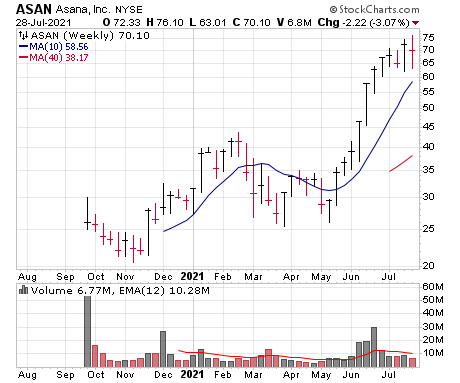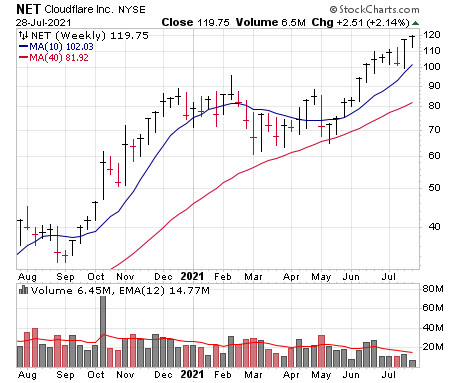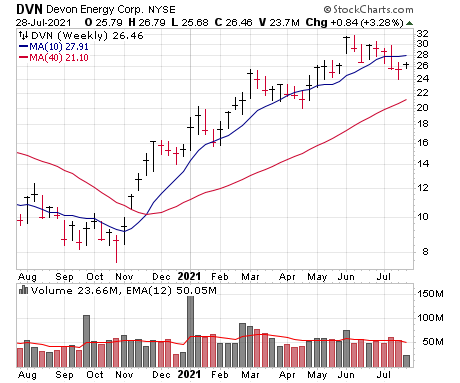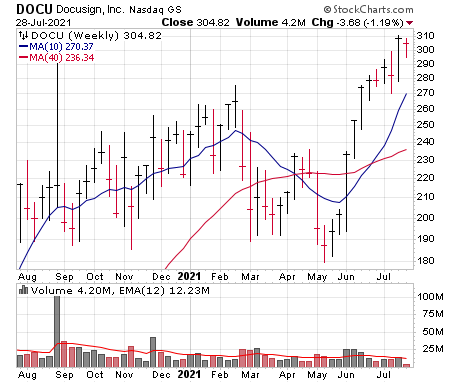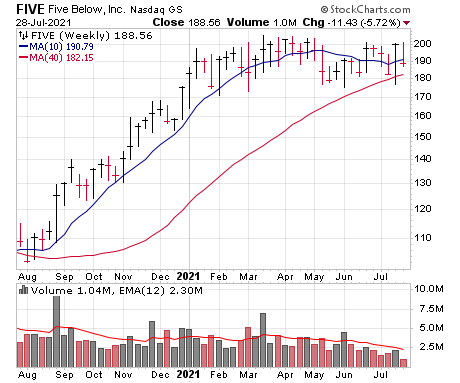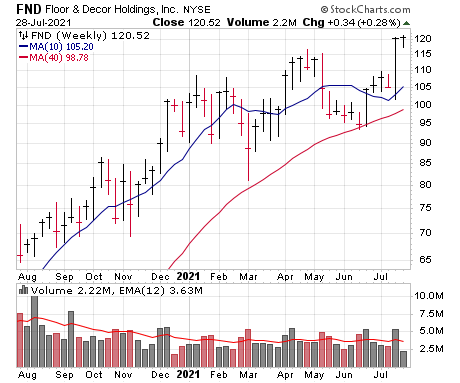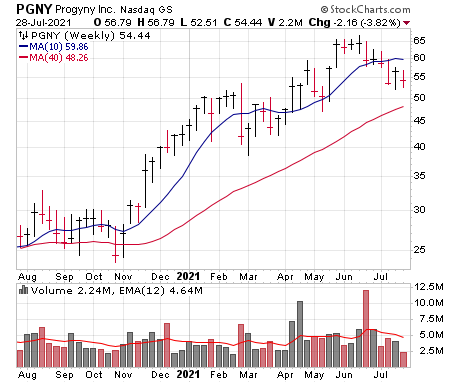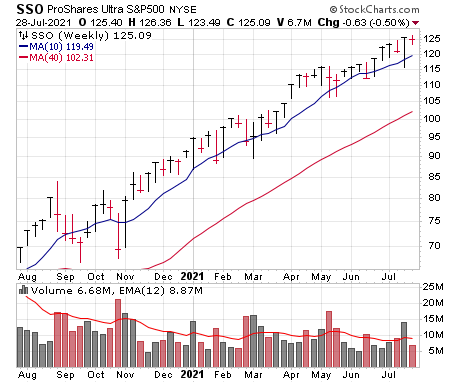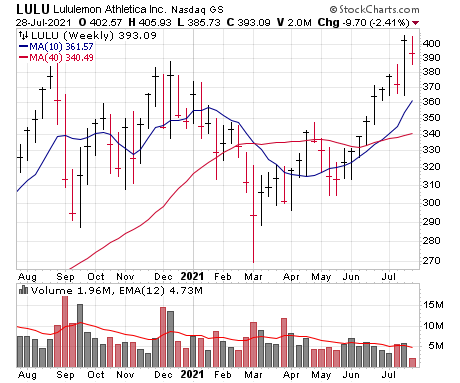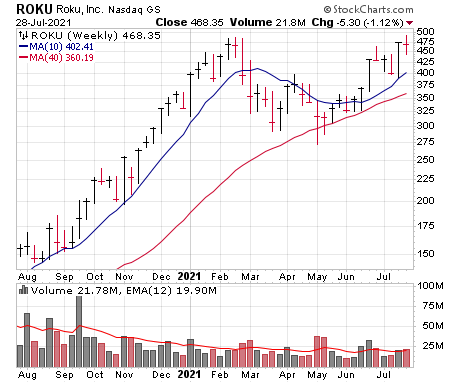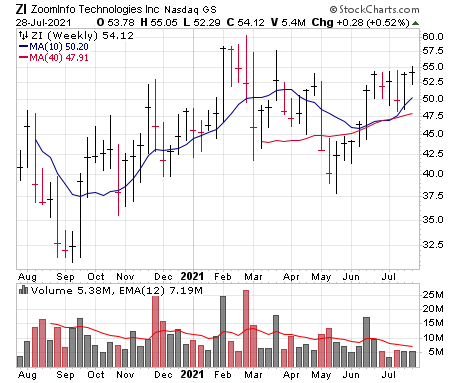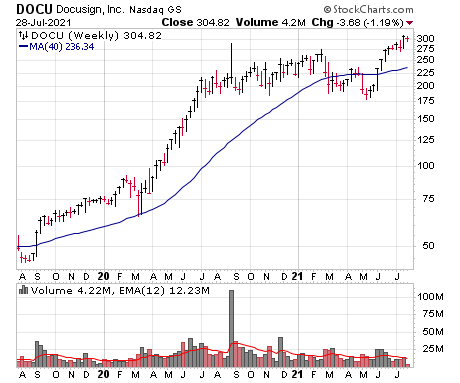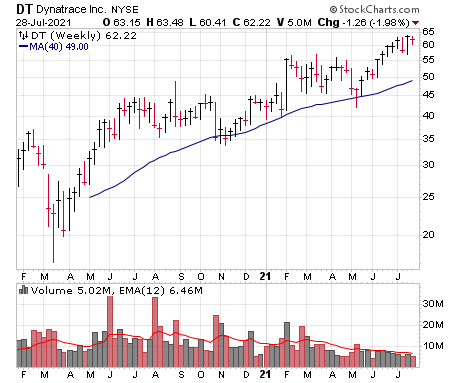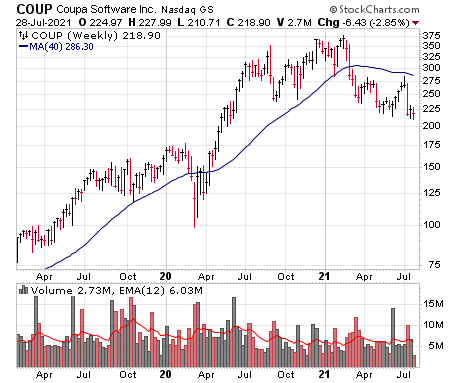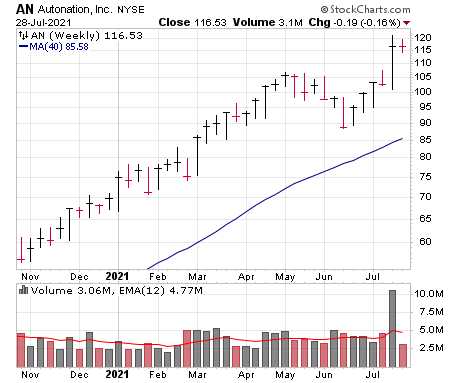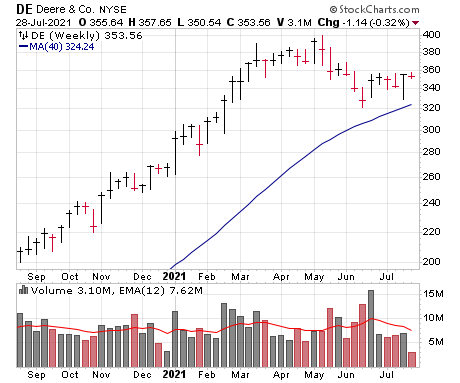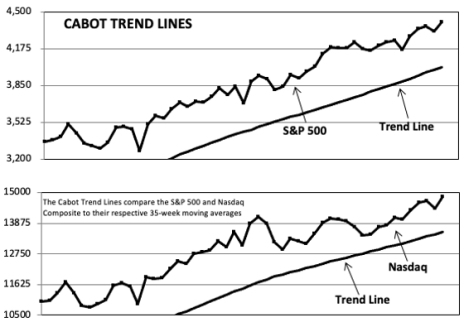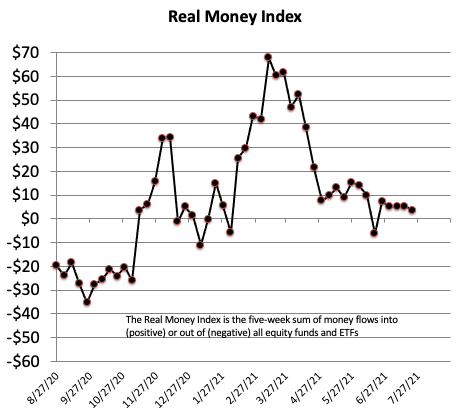There remains a lot of choppy action, where it seems like one stock does well and another hits a pothole. But we also continue to see improvement among growth stocks, with more launching pads and some names beginning to pop out to new highs. All in all, we’re paring our weakest names while holding (or averaging up in) our best performers. Tonight, we’re holding our 40% cash position but are looking to add a new holding soon if things hold together.
Cabot Growth Investor 1477
[premium_html_toc post_id="234648"]
Can Growth Break Free From the Chop?
In our opinion, there are three main things about the market that make it difficult for most investors to succeed. The first is its contrary nature—oftentimes, many of the same qualities that help you succeed in the real world (never give up, look for bargains, etc.) can get you into a lot of trouble in the market. The second is, especially with growth stocks, your portfolio will be skewed, meaning a large chunk of your profits will end up coming from relatively few trades, with the rest basically canceling each other out.
And the third tripwire that gets many investors is that returns tend to be streaky: When things are working (trending), profits tend to gush in for a few weeks or even months, but after that windfall things tend to chop around for a long time, turning investing into a grind. That chop tends to wear down investors and cause them to throw in the towel, often right before the next trend emerges.
In recent weeks, there’s little doubt we’ve still been in the confines of the chop phase—for every growth stock that gets going, it seems like another hits a pothole, making it difficult to stay on offense; it’s been a two-steps-forward, two-steps-back situation. Throw in the narrowness of the market (the 15-day average of new highs on the Nasdaq just hit an eight-month low!) and that’s why we’ve been patiently holding a good chunk of cash for months.
And yet … we continue to see increasingly constructive action among growth stocks. There are more setups for sure, with a ton having etched multi-month launching pads. There are more bullish clues, including many names that rallied a few weeks in a row (a sign of persistent accumulation) and/or big-volume rallies (including some earnings gaps). Throw in the fact that the crowd is beginning to get worried (the 15-day put-call ratio is near a 10-month high) and it’s hard to get overly defensive.
Given the fact that we’ve already had a tough growth stock correction in recent months, we’re optimistic the next big move is up and that the tedious chop phase is close to an end—but we wrote something similar a few weeks back and here we are. While we’d love to have a definitive prediction, the fact is we’re leaning positive … but need to see the bulls show their strength to get heavily invested.
What To Do Now
Until then, we’re continuing to kick out weak names and piece into fresh leading titles that should have good runs if the market can get moving. Last week, we added a new half position in Asana (ASAN) and averaged up in both DocuSign (DOCU) and Floor & Décor (FND). This week, though, we cut loose Progyny (PGNY). All in all, that leaves us with around 40% in cash—we could put a bit of that to work soon, but tonight we’ll stand pat.
Model Portfolio Update
The environment remains uneven, making it hard to make and keep much money—for every stock doing well, it seems like another fades, and market-wide, very few stocks are even in intermediate-term uptrends. With our Tides on the fence, we’re not pushing it and still have some landmines going off every now and then, with PGNY being kicked out earlier this week.
But as growth investors, we continue to see a good amount of action we like. Obviously, it’s not 1999, and even the best, most liquid names get tossed around based on the market’s daily fits and starts. But there are gaggles of six-plus-month consolidations and we’re starting to see more legitimate big-volume clues (including some on earnings).
After our sale of PGNY, we have 40% in cash; we’re looking to replace it with another stock, but tonight we’ll stand pat as we fine-tune our watch list.
Current Recommendations
| Stock | No. of Shares | Portfolio Weightings | Price Bought | Date Bought | Price on 7/29/21 | Profit | Rating |
| Asana (ASAN) | 1354 | 5% | 73 | 7/22/21 | 71 | -2% | Buy a Half |
| Cloudflare (NET) | 963 | 6% | 104 | 6/25/21 | 120 | 15% | Buy a Half |
| Devon Energy (DVN) | 7240 | 9% | 28 | 5/7/21 | 27 | -5% | Hold |
| DocuSign (DOCU) | 682 | 10% | 291 | 6/25/21 | 301 | 3% | Buy |
| Five Below (FIVE) | 852 | 8% | 138 | 9/18/20 | 191 | 38% | Hold |
| Floor & Décor (FND) | 1,845 | 11% | 111 | 4/9/21 | 123 | 10% | Buy |
| ProShares Ultra S&P 500 (SSO) | 1,741 | 11% | 60 | 5/29/20 | 126 | 110% | Buy |
| CASH | $820,142 | 40% |
Asana (ASAN)—Asana was added to the portfolio last week, and it quickly slapped us around with a sharp decline on Tuesday on no news; such is life when dealing with strong growth stocks these days. Still, while the move was a bit abnormal, shares didn’t break support, and it’s since bounced nicely. Normally the way these things work is that there will be another reverberation or two following that “shock” day, but the rebound so far is an encouraging sign, and fundamentally, we think this is a story that’s just being discovered by many investors (big and small). The stock’s 10-week line is already up around 58.5, which is near our mental stop—as we wrote in this week’s bulletin, if ASAN gives up the ghost we’ll admit our mistake and move on, but right here, we’re not ready to give up on it; in fact, we think you can start a position around here if you’re not yet in. BUY A HALF
Cloudflare (NET)—It’s hard not to be excited about Cloudflare—chart-wise, the stock has refused to pull in much even after a big run (a rarity in this environment), while fundamentally, the firm’s network and security offerings are in the right place at the right time as everything goes online. While a lot will be up to management making the right moves, there’s no reason the current customer base (17% of the Fortune 1,000) can’t grow enormously in the years ahead as most every large firm puts more and more apps and portions of its network in the cloud. Of course, that doesn’t guarantee anything; earnings are due out next Thursday, August 5 (analysts see sales up 46% and a loss of three cents per share), and the reaction to that will be key. But so far, NET’s action has been nearly pristine (volume has been light in recent days on the advance, but that’s a small fly in the ointment)—if the market can hang in there, we think NET has the makings of a leader. We’ll stay on Buy a Half, though aim for dips if you want to pick up a few shares ahead of earnings. BUY A HALF
Devon Energy (DVN)—DVN and most energy stocks have steadied themselves in recent days—it’s too early to conclude the correction is over, and we still have a mental stop in the 24 to 25 range, but it’s good to see oil prices rally back strongly into the $73 range, which should continue to mean a gusher of cash flow for Devon. As with most stocks, the next big event will be next week’s quarterly report (due Tuesday, August 3) and dividend announcement—we’re not income investors, but a beefy variable dividend payout and any forecasts for coming payouts at $60 or $70 oil could convince more big investors to hop onboard. We’re optimistic that the recent sharp correction (not unusual for energy names) will give way to a new advance, but as always, we’ll just take it as it comes: If DVN can hold up, we’re happy to hang on, but if the sellers reappear we won’t let the stock run way from us on the downside. Hold for now. HOLD
DocuSign (DOCU)—While so many growth stocks are still subject to the market’s chop, DOCU has been a pillar of strength, retreating only to its 25-day line a couple of weeks ago before rallying on good volume to take the 300 level (very similar action to NET). There’s been nothing new from the company since reporting earnings in early June (the next report isn’t likely out until early September), but as we write later in this issue, the stock has “only” had one big advance prior to this one and, following a very tedious 10-month dead period, we think most weak hands have likely been worn out. We decided to fill out our position last week given the stock’s strength and our growing profit—near term, wobbles wouldn’t be surprising (they never are in this environment), but the buyers remain clearly in control here. BUY
Five Below (FIVE)—FIVE is the poster child for the market environment in recent weeks, ping-ponging back and forth between the low and high end of its range a couple of times during the past month; the recent 10-point decline came after another rejection near 200. It’s possible this is one big topping process and if the stock melts away back into the upper 170s, we could take the rest of our profit and look for stronger situations. But, frankly, we like the overall setup here: There hasn’t been a down week on above-average volume since early April, the biggest volume clue during this consolidation was on the upside after earnings in June and, of course, the cookie-cutter growth story has years to play out—if we see a big-volume move above 200 or so, it should kick off a fresh uptrend. For now, though, we’ll just follow the evidence, and with FIVE’s pattern remaining sideways, we’ll stay on Hold. HOLD
Floor & Décor (FND)—We had been watching FND for many months before pulling the trigger, and even after our initial buy in April we had to endure two months of frustrating action. But now we think our patience is paying off, as shares have come under strong accumulation in two separate waves (late June and again last week), lifting out of what was essentially a seven-month base-building effort. To be fair, the picture isn’t perfect (the relative performance line is still shy of its highs), and Floor & Décor reports earnings next week (August 5) along with so many other names—revenues are expected to be up 98% from last year’s pandemic-affected quarter, with earnings of 61 cents per share. We always want to have a plan, so a sharp dip back toward the century mark would tell us this breakout attempt has failed, which in turn would make a meaningful decline more likely. But right now, we’re not thinking that way: It’s likely most weak hands have been worn out, and while there can always be some near-term changes in the demand picture, little is standing in the way of the company’s growth outlook. We’ll stay on Buy, though if you’re starting out, keep new positions small this close to the report. BUY
Progyny (PGNY)—Everything we’ve written about Progyny in recent weeks remains true—we think the firm’s overall growth story is excellent and unique, and that should lead to years of solid growth. But whether it was the timing of our half-sized buy, the market environment or a combination of both, PGNY just couldn’t get out of its own way in recent weeks, and we decided to cut the loss on our special bulletin this week. We’re not ruling out re-buying if the stock sets up again down the road (it will report earnings next Thursday, August 5, though we’re not sure we’d chase a gap higher in the name at this point), but the fact that PGNY has been slipping while most growth-oriented stocks have perked up has us looking for greener pastures. SOLD
ProShares Ultra S&P 500 Fund (SSO)—When I started with Cabot 22 years ago right out of college, I went down the rabbit hole looking for all sorts of market timing systems and indicators that could give us an edge. Some were OK, but nothing really beat trend following, which wasn’t perfect (no system is), but by its very nature never had you missing out on a major uptrend or (more damaging) sitting tight during what ends up being a horrid downturn. The past few months really couldn’t have provided a better example of that, as investors who’ve analyzed dozens of economic and market factors didn’t do any better (and many did worse) than just following the S&P 500’s trend. Today, the trend for the S&P 500 (and, hence, SSO) remains up, so we’re happy to continue holding on. Granted, there remain yellow flags out there, not the least of which is the neutral Cabot Tides and narrowness of the advance, so we’re not complacent; a drop below 117 at this point would have us going to Hold if not selling a piece of our holdings. Right now, though, SSO’s sharp rebound from the shakeout last Monday bodes well. BUY
Watch List
- Bill.com (BILL 206): BILL remains choppy, but the trend is clearly up and it handled this week’s shake nicely. Earnings are likely out in mid-to-late August.
- CrowdStrike (CRWD 260): CRWD’s story, numbers and chart all suggest good things. About the only thing to complain about (something you could say about many growth stocks) is the RP line, which has yet to reach virgin turf—but we think it could do so soon.
- Dynatrace (DT 64): DT reported a fine quarter on Wednesday morning (sales up 35%, annualized recurring revenue up 37%, after-tax profit margin of 21%), and the stock has popped to new highs. We like this story a lot and may take a position soon if the stock can show some strength.
- Snap (SNAP 75): SNAP gapped to new highs after the Q2 report crushed expectations and backs up the view that 50%-plus annual growth should be here for years to come.
- ZoomInfo (ZI 54): It still has some work to do (60 is major resistance), but ZoomInfo has the makings of a fresh leader—if earnings, due out next Monday (August 2), are well received. See more below.
Other Stocks of Interest
Lululemon (LULU 403)—Lululemon isn’t a new name to Wall Street, but it’s seeing its earnings really take off as it pulls the right levers when it comes to new products, M&A and international expansion. Lululemon was the early leader in athleisure apparel (comfortable, but also versatile and stylish), and while competition from the likes of Gap (with its Athleta brand) and others has picked up, Lululemon has stayed ahead of the game by expanding its offerings—whereas it used to sell just higher-end women’s yoga wear, it now offers products for both men and women (men’s is actually growing faster) in a few categories including yoga, running, training and on the move (travel-friendly wear). Plus, via the purchase of MIRROR, it’s now involved in the interactive in-home fitness sector; the offering has been growing rapidly from its launch just three years ago (sales of around $265 million this year) and Lululemon plans to have a couple hundred “stores-in-stores” down the road. Throw in booming e-commerce (sales up 50% in Q2) and international segments (China sales are growing at a 90% rate), along with a rebounding in-store business (Q2 in-store sales were actually up from 2019 levels) and the bottom line is taking off, with analysts seeing earnings rising 46% this year and another 22% next, both of which are likely to prove conservative. As for the stock, it was an early post-pandemic winner, but it topped out near 400 on Labor Day, corrected as much as 33% and has built a big 11-month launching pad since. But in recent weeks, LULU’s character has changed, with the sellers nowhere to be found as shares attack new high ground. It’s not the young pup it used to be, but we think shares are starting another run. The next quarterly report isn’t likely out until early September.
Roku (ROKU 450)—Roku was one of our big winners last year; we had planned to hold onto our remaining chunk through a correction as the stock still appears to be early- to mid-stage in its overall advance (see more on that below), but the company’s story changed somewhat—instead of sticking with being a neutral portal that consumers used on their way to stream others’ content (indeed, one of Roku’s big draws was that it benefited from all the new streaming services out there, rather than competed with them), it decided to itself get into the content game, spending lots of money ($1 billion next year) on developing its own shows and podcasts. The goal was noble—with better content for its own Roku Channel (which is free to users), it would have more sway with advertisers, but the risks were obvious as spending and costs soar. However, so far, management seems to have hit a home run, or at least a solid double: Just as advertising budgets are ramping up and as money is rapidly going from linear (traditional) TV to streaming platforms, Roku’s new content (30 new shows launched in late May, mostly from a prior acquisition) brought record traffic to the Roku Channel, with one in three users streaming at least one of the new shows. (There should be 45 more new original shows launched later this year.) The combination of it all has had advertisers clamoring for spots—the top brass said that upfront ad commitments for next year have doubled from this time a year ago, and that’s a good thing, as the firm historically retains 95% of its advertisers going ahead. Long story short: The growth story here could actually be better than before, as the core cord-cutting theme remains strong and the new content angle could accelerate advertisers’ move to its platform. As for the stock, the base was deep and the action has been wild, but overall ROKU has pushed back to its highs ahead of earnings next week (August 4). Let’s see how it reacts to the report.
ZoomInfo (ZI 54)—We had ZoomInfo in our sights back in February, but the market obviously had other ideas, dragging it lower along with most growth stocks. But shares have set up nicely ahead of earnings and the story hasn’t changed—in fact, we think it’s improved. The company has what it dubs the leading go-to-market intelligence platform, using AI and machine learning of publicly available data, along with some information sharing among clients, to provide a much more detailed, accurate and dynamically-updated data set for sales professionals that’s extraordinarily broad (monitors tens of millions domains and record events daily). Effectively, the platform allows sales people to do less information gathering and busy work (which currently takes up a majority of their time!) and do more selling, which of course is a good thing. And the product is integrated into many of the leading CRM programs, such as HubSpot, Salesforce and others. In recent months (mostly through M&A), ZoomInfo has expanded further, and now sees its potential market north of $30 billion—and, in its first-ever Analyst Day in June, the top brass believes it can keep revenues growing at 30%-plus rates through at least 2025. As for the here and now, growth is even better than that (up 50% in Q1) and, impressively, earnings are solidly in the black and profit margins are bulky, too, with rapid, reliable growth likely for a long time to come (analysts see earnings up 43% this year and 30% next). As for the stock, ZI came public 13 months ago and has set up a huge post-IPO base, a pattern similar to what many past winners (Facebook, Alibaba, LinkedIn) have lifted off from. We’re not saying it’s necessarily going to be a monster stock, but it has all the characteristics of a name that will keep big investors interested. ZI is on our watch list; earnings are due out August 2.
Still Many Early- and Mid-Stage Opportunities
When you combine the choppy, frustrating environment for growth stocks, a neutral intermediate-term trend and the iffy action of some secondary indicators, many investors are beginning to wonder whether this bull market is nearing an end. The fact that the virus’ latest strain is leading to some early restrictions also doesn’t help the cause.
But there are two things that have us believing this bull market has a ways to run. The first is easy to explain: The Cabot Trend Lines, which is our oldest and most reliable indicator, continues to remain solidly positive—with the major trend being up, the odds favor higher prices in the months ahead.
The second reason, while less obvious, is just as encouraging: Among growth stocks, there are still tons of “early-stage” situations that appear to be in the early or middle innings of their overall runs. Some enjoyed large runs post-pandemic, but in many cases (a) that was the stock’s initial run, and (b) it’s been followed by a multi-month rest that refreshed the major uptrend. And then there are others that are setting up initial post-IPO structures or have just started to get going.
To us, DocuSign (DOCU) is a classic example of the first scenario. It was obviously one of the biggest pandemic winners, but after the original breakout in September 2019, shares advanced for “only” 11 months before topping out and acting terribly for the following 10 months. Thus, the current rally is just the second one since DOCU got going; all else equal, it should work.
Then there’s a name like Dynatrace (DT)—shares never really enjoyed a sustained advance before starting a massive, year-long consolidation. Only recently has the stock popped to new highs; if the market gets its act together, a name like DT should have a sound launching pad to work higher from. There are a lot of stocks that have the look of either DT (possibly just starting its first major advance) or DocuSign (entering its second big run).
Conversely, the later-stage names are mostly looking ragged, which isn’t surprising; after running for a couple of years, the buying power gets spent and the story becomes obvious, leaving the sellers to take control. The most glaring example is Coupa Software (COUP): It originally broke out in early 2018 and had a great run into mid 2019. After many months of chopping around and a crash last March, COUP had its second run higher—but after topping out earlier this year, the stock is now languishing below its 200-day line.
Obviously, there are no guarantees in the market, but the fact that many growth titles are still likely in the early to middle innings of their overall advances is a plus—and should mean there will be a lot of names we can sink our teeth into if/when a sustained run in growth stocks really gets going.
One Interesting “Theme” to Watch
Our main bag will always be growth stocks, but as part of our regular screens, we’re seeing an interesting theme emerge: A handful of bigger companies are seeing their earnings profile improve dramatically for one reason or another (often related to the new post-pandemic world), and that’s helping their stocks surprise on the upside.
Chipotle Mexican Grill (CMG), which we wrote up in the last issue, is an example of this—its boom in digital orders and takeout has significantly hiked the revenue it can generate per store in both the near and longer term. Last week’s Q2 report blew away expectations ($7.46 per share was 92 cents above estimates), causing the stock to soar and earnings estimates (up 138% this year, up 31% next) to rise.
Lululemon (LULU) is another example—it was already on a solid growth path, but now the bottom line is going through the roof thanks to new products, e-commerce and international expansion. (See more earlier in this issue.) Shares are knocking on the door of all-time highs.
AutoNation (AN) is the nation’s largest auto dealer, which isn’t a thrilling business. But a combination of limited supply, rising demand and a very bold share buyback program (management repurchased 15% of the company in the first six months of the year!) has caused business to mushroom—earnings were generally in the $4.50 area pre-pandemic, but they lifted to $7.12 last year and should get close to $15 (!) this year before a little backing off. The stock has had a good run but it only recently staged a fresh breakout on earnings.
Lastly, take a gander at Deere (DE), the agricultural equipment giant—after three years of flat-to-down earnings, the economic rebound and commodity inflation has caused demand to surge: Analysts see earnings more than doubling this year and expanding another 17% next. The stock is base-building after a big run; the next wave of big-volume buying could be interesting.
Usually you won’t see such business improvements from large-cap names, but the unusual economic happenings of the past year look like they’ve created some opportunities in some of these bigger, liquid names.
Cabot Market Timing Indicators
Growth stocks continue to improve their positioning, but it’s certainly not smooth, with the market gyrating based on the news of the day and many investors rowing in different directions. We’re cautiously optimistic, but are still holding onto some dry powder until more growth titles get moving.
Cabot Trend Lines: Bullish
Our Cabot Trend Lines remain solidly positive, with the S&P 500 and Nasdaq closing last week 10% and 9% above their respective 35-week moving averages. There are still a lot of questions out there, from growth stocks to the broad market, but the longer-term trend isn’t one of them—it remains clearly up.
Cabot Tides: On the Fence
Our Cabot Tides tipped into a sell signal at the start of last week, but quickly reversed—not enough for a new buy signal, but the intermediate-term trend is effectively back to neutral. The big-cap indexes (including the Nasdaq, shown here) are still the strongest of the bunch, but much of the broader indexes haven’t gone anywhere in months. Thus, the rebound is encouraging, but not conclusive quite yet.
Cabot Real Money Index: Neutral
We continue to see a decrease in optimism among investors from a variety of measures, including our Real Money Index: While we’d love to see a spike lower (to show some real fear), the current reading is the second lowest since mid-January, which is a decent contrary sign that a good number of weak hands have been worn out.
Charts courtesy of StockCharts.com
The next Cabot Growth Investor issue will be published on August 12, 2021.
Cabot Wealth Network
Publishing independent investment advice since 1970.
President & CEO: Ed Coburn
Chief Investment Strategist: Timothy Lutts
Cabot Heritage Corporation, doing business as Cabot Wealth Network
176 North Street, PO Box 2049, Salem, MA 01970 USA
800-326-8826 | support@cabotwealth.com | CabotWealth.com
Copyright © 2021. All rights reserved. Copying or electronic transmission of this information without permission is a violation of copyright law. For the protection of our subscribers, copyright violations will result in immediate termination of all subscriptions without refund. Disclosures: Cabot Wealth Network exists to serve you, our readers. We derive 100% of our revenue, or close to it, from selling subscriptions to our publications. Neither Cabot Wealth Network nor our employees are compensated in any way by the companies whose stocks we recommend or providers of associated financial services. Employees of Cabot Wealth Network may own some of the stocks recommended by our advisory services. Disclaimer: Sources of information are believed to be reliable but they are not guaranteed to be complete or error-free. Recommendations, opinions or suggestions are given with the understanding that subscribers acting on information assume all risks involved. Buy/Sell Recommendations: are made in regular issues, updates, or alerts by email and on the private subscriber website.
Subscribers agree to adhere to all terms and conditions which can be found on CabotWealth.com and are subject to change. Violations will result in termination of all subscriptions without refund in addition to any civil and criminal penalties available under the law.
